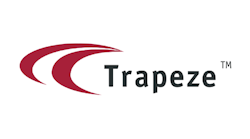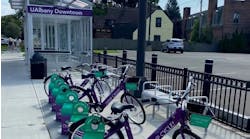Across America top CEOs and their teams are focused on keeping the nation’s transit systems running safely, efficiently, reliably and with world-class customer service. But when they are not working on getting positive train control (PTC) installed in their commuter trains, renegotiating labor contracts or working on getting more funding, three primary issues keep them up at night:
1. Aging infrastructure: Not a month goes by lately without a disaster for some transit system whose subway tunnels flood or trains derail. While many systems were growing by adding new service over the last decade, too many have failed to maintain their infrastructure in a state of good repair. This is one of the reasons for the Federal Transit Administration's guidance on requiring better asset management.
Publicly elected officials too often will sacrifice long-term system needs, such as mid-life cycle overhauls of light rail vehicles or major track replacement for a “sexy” new light rail extension to the airport. While they are only listening to their constituents who want the system to serve new areas, this is often short sighted when done at the expense of system safety upgrades. These elected officials often will argue that ridership is declining because their system does not currently serve the needs of today’s commuting public, so the new rail line must be constructed.
But transit CEOs are working to educate their board members, mayors and council members on the importance of investment in state of good repair because they know that one significant safety issue can set a system back a decade in public trust. Without public trust, you can kiss increased ridership goodbye. You don’t have to look far to find an example close to home.
No one wants their system to be next so Transit CEOs are working to shift millions of dollars in their capital budgets to emphasize track and track exchange replacements, CAD/AVL dispatch system upgrades, and new or overhauled trains. They are also trying to find the balance between expanding their system and maintaining it adequately. Many are turning to the less costly approach of rebooting their bus route network to better meet the current travel demands of existing and potential new customers. This is a much less costly approach and allows them to maintain a focus on state of good repair for their rail infrastructure.
2. Decreasing Ridership: The American Public Transportation Association (APTA) data shows that from 2014-2016 nearly every major transit system in America saw a decline in ridership. The national average was a loss of 4.5 percent of transit ridership over that time. Lower fuel costs, the uptick of new transportation options from companies like Uber and Lyft and an increase in telecommuting are often cited as reasons for this decline. At APTA’s most recent CEO conference in San Diego, this topic was a main point of concern among the attendees as top association officials presented their findings.
A recent ENO Transportation article noted the National Transit Database (NTD) showed an actual decline of 5.2 percent in the number of miles traveled by the nation’s public bus systems from 2009-2014, so this certainly has contributed to the overall ridership decline.
What are Transit CEOs doing to address this troubling trend? As noted above some are expanding their rail network like New York City, Los Angeles and Charlotte. Others are reviewing their bus route networks that were laid out 50 years ago and seeing if it is time for a system overhaul with reconfigured routes that emphasize high frequency transit (a concern often expressed by riders is the length of time they have to wait at a bus stop), more time point reliability and real-time apps. These cities, such as Houston, Baltimore and Seattle, are setting a new trend by focusing on upgrading their “work horse” public bus systems with the latest amenities and rebooted route networks. Some systems like the one in Baltimore are also rebranding their buses with all new colorful wraps, new bus stop signs and logos. The jury is still out on whether this approach of focusing on bus network design and route reliability and efficiency will halt the trend of declining ridership, but initial results are promising.
3. Paratransit Cost Escalation: Cities across America are coping with the growing cost of complying with the Americans with Disabilities Act (ADA) requirement of providing commensurate paratransit service for people with disabilities. Costs now hover at about $50 per trip for this curb-to-curb service (or door-to-door in many cities). While overall transit ridership is declining across America as noted in No. 2 above, in many cities, paratransit ridership is increasing. Most transit systems outsource the provision of this paratransit service to private transit contracting companies such as Transdev, First Transit or MV, but even with these cost-saving measures, the overall cost to provide this reservations-based service is eating up 10 to 15 percent of many transit systems’ operating budget while only providing about 2 to 3 percent of their overall ridership.
What are Transit CEOs doing to cap or reduce these costs? Many are looking to taxis or the new transportation networking companies such as Uber and Lyft to help take some of the load with costs for these services coming in on average at one half (e.g. about $25) the per-trip cost of the traditional contracted wheelchair lift-equipped vehicles. Many transit agencies are now taking a fresh look at travel training to encourage regular riders to take the lower-cost fixed-route service or offering certified ADA users free rides on fixed route. Transit managers are focusing on increasing trip productivity while maintaining their eye on keeping on-time performance (OTP) above 90 percent. Still others are looking to technology to lower cost, including on-line ADA certification or trip booking to lower the cost of reservations.
New innovations such as mobile and contactless credit card payments, the Internet of Things (IOT) expansion into transit applications and new autonomous shuttles make the headlines and are exciting new developments that CEOs are pursuing. But the “bread and butter” issues of maintaining an aging infrastructure, addressing declining ridership and better managing paratransit cost are the big concerns on the minds of America’s transit CEOs. Private industry companies that can develop potential solutions to assist them in these areas are sure to be in demand.
Paul Comfort, Esq. is a VP of Business Development with Trapeze NA, the former CEO of the Maryland Transit Administration and winner of the 2016 AASHTO President's Award.



